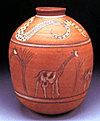
|
|
|
|
|
|
|
Gallery
Tour
ANCIENT NUBIA The statue of the scribe Amenemhat (left) shows a man who looks very Egyptian. He wears the short kilt and shoulder length wig typical of an Egyptian courtier; however, Amenemhat was a native Nubian who served as a scribe under Queen Hatshepsut (1479-1458 B.C.). Images such as this show close interaction between Nubia and Egypt during the New Kingdom, a period in which much of Nubia was ruled by Egypt. This statue was found in the temple of Horus at Buhen, where it had been presented to the temple with the hope that Amenemhat could be near the god Horus and could share in the temple rituals after his death. The hieroglyphs along his arm identify him by title and name. Ba figures are small statues that represent a tomb owner with wings. The ba was believed to be part of the person's spirit that could travel outside the burial chamber after death. In Egyptian representation, the ba was usually shown in the form of a small, human-headed bird. The Meroitic Nubians reinterpreted this concept and produced these characteristic statues showing the deceased in fully human form, but with the wings of a bird. On their heads, they wear a sundisk. Pottery from Meroitic Nubia (100 B.C.-A.D. 300) comes in a vast array of shapes and styles. At this time in Nubian history, pottery was being mass produced yet the vessels often are vibrantly decorated and one characteristic style contains lively polychrome scenes of Nile life and landscapes such as aquatic plants and crocodiles. The jar to the left has a giraffe and undulating snake motif. The giraffe was not native to this part of Nubia and the artist may have based his painting on verbal descriptions of the animal. |
|
[top] |
|
|
|
|
|
|
Egypt
Home |
Expeditions Past and Present | Gallery
Tour | Gods and Goddesses |


